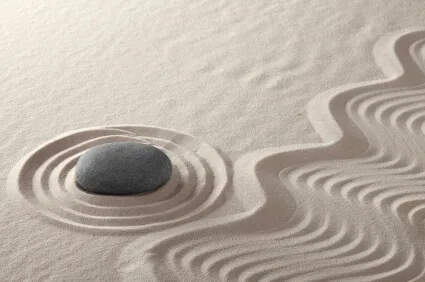
- Share on Facebook66
- Share on Pinterest
- Share on Twitter
There is much to be said of the therapeutic benefits of nature and being still in nature. Just spending time outside, under the sun, enjoying the birds and fresh air, is not only revitalizing but also very healing.
Even modern day medicine is beginning to realize the powerful capabilities of nature. Healing and meditative gardens are springing up all over the country in medical facilities. Research has demonstrated that nature reduces anxiety and hastens post-surgical recovery.
What is A Zen Garden?
The Zen garden, which is also known as the Japanese rock garden, is an ancient garden design that uses elements found in nature such as rocks, grass, sand and plants to create a place of refuge.
The mind is a busy place, and Zen gardens are designed to provide a peaceful retreat without distractions where one can become still. Sand is raked to look like ripples in the water and rocks can be stacked like mountains or other natural elements. Fountains and plants are often used to further enhance the garden’s restorative appeal.
Ancient Buddhists employed these gardens as a tool for meditation, and many ancient Japanese rock gardens can be found within the walls of Buddhist monasteries. Some of the most complex gardens are actually based on mathematical principles.
In Kyoto, Japan, the Ryoan-ji Zen Temple includes 15 boulders, but they are set up in such a fashion so that you can only see 14 boulders at one time no matter what angle you look from. This stacking method is achieved through a model of shape analysis called medial axis transformation.
Western Zen Gardens
Zen gardens in the west range from extremely simple to highly elaborate, and are recognized as places of soothing tranquility. In today’s high-stress world, where so many people suffer from anxiety, depression and other related conditions, a place to relax and “let down,” can help re-balance the mind and body.
Many people are drawn to the enigmatic character of the Zen garden. Much of the garden design is dependent on what the creator puts into it and how it is used conceptually.
If you have a little space, and a desire for some peace in your life, consider creating a Zen garden of your own.
How to Make a 12×12 Zen Garden
Materials Needed:
- Measuring tape
- Wooden stakes
- Rubber mallet
- Landscape fabric
- Landscape pins
- 1-by-12-inch lumber, 12-feet long
- 3-inch wood screws
- Drill
- Gravel
- Playground sand
- Large rocks
- Potted plants
- Wooden rake
- Small fountain
- Bench
 Instructions:
Instructions:
- Measure out and mark a 12-by-12-foot square in desired location for your Zen garden. Mark each corner by pounding a wooden stake into each corner in the square using a rubber mallet.
- Cut strips of landscape fabric to cover the square. Lay the fabric out and pin it down with landscape pins. This will prevent weeds from growing up into the garden.
- Lean the 12-foot boards up against the wooden stakes to form sides for the garden. Use three 3-inch wood screws on each corner to attach each of the boards to the stakes. This will keep the sand and gravel from pouring out from the sides of the garden.
- Cover the bottom of the garden with 3 inches of gravel. This will help with drainage.
- Fill the rest of the garden up with sand.
- Place rocks in the garden in various locations. Traditionally, Zen gardens have an odd number of stones. Bury the stones halfway, so it looks like they have always been there; this gives the garden a more natural look.
- Add potted plants in different locations to give detail to the garden. Use a wooden rake to smooth the surface and create designs in the sand.
- Place a small fountain in one corner of the garden along with a wooden bench or chair.
-The Alternative Daily
- Share on Facebook66
- Share on Pinterest
- Share on Twitter

